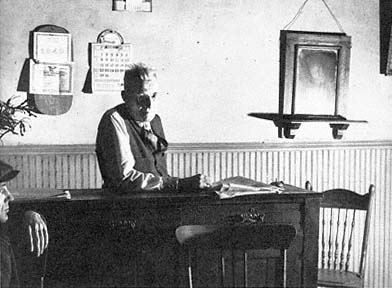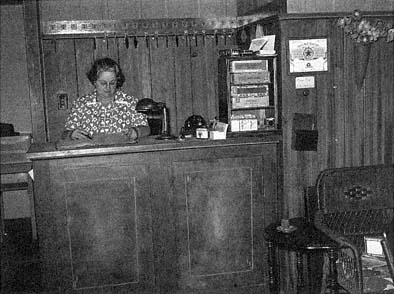Managers
As many as nine out of ten owners of large hotels did not personally manage their property. To the owners, the hotel was often strictly a real estate investment, no more meaningful to them than a speculative office building or warehouse. They typically leased the building to a manager for one to ten years. The contract details varied: a high fixed fee per year gave the owners a guaranteed income and left the remaining profits to the managers; leases at lower annual rates gave
the owners a percentage of the gross receipts. Either method repaid construction loans quickly and gave the owner relatively worry-free income as long as hotel business was good at that location. At the turn of the century, owners proudly announced the cost of the lease (along with the cost of the building if it was new) in the local newspapers. In 1909, for instance, the Haas Realty Company began a $95,000 hotel just two blocks from San Francisco's Union Square. While construction was under way, they sealed a lease with the first manager, who over ten years was to pay the company $177,600 to operate the 108-room hotel and its ground-floor German grill.[16]
Hotel furniture often belonged to the manager, not the building owner; change of management included the sale of interior furnishings. In the 1890s, new furniture and fittings of an elegant family hotel might cost $400 a room, while a few blocks away, the manager of a cheap rooming house might pay only $50 a room. In the midpriced hotel range, the fittings, furniture, and dining room equipment could cost as much as 60 percent of the cost of the building.[17]
Published guides existed to help managers decipher the commercial metabolism of the United States, but most hotel owners and managers relied as much on hunches and personal experience.[18] While bargaining on a lease for a hotel with a bar and dining room, the astute hotel manager counted on the bar for positive cash flow. Dining rooms, other food service, and hotel entertainment offered virtually no chance for profit; at best, they broke even. The bar, however, generated a hefty share of the hotel's income and often paid rent, heat, and light for the whole building. Similarly, store rentals on the ground floor often carried the hotel's interest charges and some of the mortgage principal.[19]
Managers needed leadership ability, sound judgment, and good legal counsel for the daily demands of coordinating a complicated staff. At a polite hotel, that meant a 24-hour supply of maids, bellboys, elevator operators, kitchen assistants, janitors, and plumbers, along with a sizable number of clerks and midlevel supervisors. Much of the hotel management literature chronicles labor strife and methods to reduce it. To keep good workers nearby, builders of large hotels often constructed rooms in the attic or at the back of the hotel as living quarters for a share of the employees. Owners of gargantuan hotels like San Francisco's Palace built neighboring rooming houses with one hundred rooms or more, largely rented to their staff. Rooming houses and cheap lodg-
ing houses required a smaller but equally essential supply of maids and repair people.
Besides assuring the necessary staff support, the motive of a hotel manager was filling as many rooms as possible every night. In 1930, a hotel management report put it this way:
Hotel business differs from the general run of manufacturing in the perishability of its product. Time . . . is the major item that a hotel man has for sale. Every unsold room in his house every night represents an irretrievable loss, for that night will never return.[20]
To attract and keep permanent residents, managers of all types of hotels had to give appropriate attention to their clients, and the manager-tenant relationship was often very personal. Palace hotel managers personally assured wealthy clients that they would have the same suite each year and welcomed them with flowers and a personal note in their room when they arrived. Other managers chatted with tenants daily, or if they were managing a rooming house with elderly residents they helped them read and write letters, do their shopping, make doctor's appointments, or arrange ambulance service. At cheap lodging houses, good clerks made a point of greeting tenants by name and playing host to the group in the lobby to give them a sense of belonging and being at home (fig. 6.6). During strikes, rooming house keepers won loyalty from tenants by extending credit until the strike was over.[21]
When Prohibition cut off bar receipts, even more of the manager's attentions went to maintaining high room occupancy. By the 1920s, in a larger hotel a room occupancy rate of 70 percent was usually needed to break even. Seasonal changes in occupancy were another cash flow reality. When transient guest numbers were low in most palace and midpriced hotels, managers often took in more permanent guests. Monthly room rates were always substantially lower than the prorated daily or weekly rates—often only a fraction of the daily rate—but nonetheless managers could count on that residential income to cover fixed operating expenses.[22]
On similar sites, hotel buildings were known as potentially higher income properties than apartment buildings. Hotels made less money than apartments during business troughs but much more money in busy seasons. Apartments usually offered relatively steady cash flow year-round.[23] After 1920, real estate investors with a small amount of

Figure 6.6
Desk clerk in a cheap lodging house in Dubuque, Iowa, photographed in 1940.
Note the casual arrangement of chairs.
capital, or those who wanted to rely on a housing investment as a significant part of their day-to-day income (for retirement income, perhaps), seem to have preferred apartments over hotels.
In the 1890s, the majority of the midpriced family hotels in San Francisco were run by women managers, and women managers were also reasonably common in other types of hotels. A California journalist explained in 1892 that the woman in business may have been questioned in some quarters, but "as a manager of large family hotels and rooming-houses, she is an eminent success" (fig. 6.7).[24] In 1900, up to 95 percent of American rooming house keepers were women. In most cities, about half of these rooming house operators were widows; the married rooming house operators typically had husbands who were wage laborers. Income from small rooming houses was more touch and go than at larger hotels. Unless the woman owned the building, its revenue was not substantial. The small rooming house operators leased their building by the year and bought the furniture on time payments. Typically, both the lease and the furniture purchase were arranged through a real estate broker who specialized in such deals and either owned the buildings outright or managed them for investors.[25] In spite of the meager income available, becoming a rooming house keeper was one of the occupations most available to mature self-supporting women before World War II. Older waitresses, for instance, commonly dreamed of leasing a rooming house instead of slinging hash in a cheap

Figure 6.7
Desk clerk in a small rooming house in San Augustine, Texas, 1939.
Even in the nineteenth century, women were commonly hotel keepers.
restaurant. Yet many women went broke in their first year, not realizing the seasonal shifts or other expenses. They lost the money they had paid on the furniture and had to forfeit everything to the rooming house brokers. The brokers then easily found another recently widowed woman willing to invest her small nest egg on a rooming house venture. Rooming house real estate brokerages were so shady that some hotel brokers, to appear reputable, overtly advertised "strict conformance to upright business principles."[26]